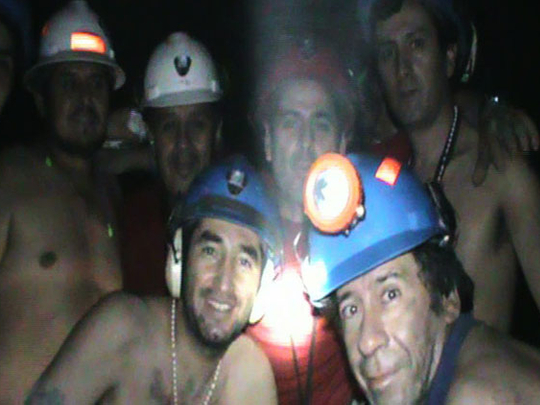
It is the most eagerly followed rescue mission since April 1970, when the astronauts aboard Apollo 13 declared, with famous understatement: "Houston, we've had a problem."
However, the world's attention this week is not focused on the skies but towards the depths of the earth, where 33 miners have been stranded nearly half a mile below ground in northern Chile following a disastrous cave-in nearly 70 days ago.
At the minehead in the desolate terrain of the Atacama Desert, the escape shaft has been drilled, the steel lining is being inserted, the rescue capsules have been tested, and the winch system that will haul the pod up is being put in place.
On a rocky outcrop, a viewing platform is also being erected for a strictly rationed number of media representatives to watch as the first capsule reaches the surface at San Jose mine — an event currently scheduled for this morning. The world's press and television have descended in force, turning the relatives' Camp Hope vigil site into a sprawling community of Winnebagos, portable toilets, satellite dishes and state-of-the-art tents.
After surviving underground longer than anyone in history, they will face another ordeal from a world desperate to hear their stories of subterranean incarceration. And journalists, authors and Hollywood movie producers, some waving large chequebooks, are desperate to narrate it.
The attention of the media is just one of the challenges that the miners will face when they are released after spending two or three days in hospital in the nearest town of Copiapo for mental and physical evaluation.
"One thing that is certain is that their lives will never be the same again," said Dr Alberto Iturra, the laconic Chilean psychiatrist who is leading a 20-strong team of therapists at San Jose.
Despite the hand-written notes that have become part of the daily ritual, the miners and their families have inevitably had an inordinate amount of time to reflect on their relationships with their nearest and dearest since the rock-fall on August 5.
Some will come out stronger. For example, two couples who were married long ago in civil ceremonies are planning church celebrations — and at least one bride-to-be has suggested that newspapers might like to buy her a dress and sponsor the event in return for OK!-style exclusive coverage.
Others will need the help of marriage guidance counsellors after competing claimants for their affections turned up at the vigil site. Red Cross workers there said that, sadly but inevitably, the expectations of future riches were behind some espousals of affection. But Dr Iturra also warned that the miners could face the equivalent of post-traumatic stress disorder.
Families who have learnt to function without the patriarch in a male-dominated culture will also have to adjust to the man's reappearance — another echo of soldiers coming home from the front.
The celebrity status is going to be a particular challenge for men who hail from small, close-knit communities and who tend to be deeply private and reserved. The fortunes that will come with fame for men who previously earned an average of $1,000 (Dh3,673) a month digging for gold and copper will also pose fresh problems.
Film and book deals
As well as the immediate media crush, there are also lucrative film and book deals being touted around. Underground, the men have kept their shift and leadership systems alive — a set-up that has been widely credited with maintaining their calm and strength as the weeks dragged on.
But whispered around the logfires at Camp Hope as the chill of the desert night kicks in are unconfirmed stories of disputes and clashes underground, both during those desperate first lost 17 days and also more recently over how they will deal with their new-found fame.
The television news programmes they watch in the "camp" (their living quarters) have left them in no doubt that they will emerge as international celebrities. And there are some signs that the men have recognised the value, tactically and financially, of sticking together: they have apparently reached an agreement to share the profits made from recounting their ordeal.
In communications from below, they have called on a lawyer to draft a contract stipulating that they will profit equally from media deals. The lawyer may have his work cut out to enforce the terms because there will be much greater interest in the stories of some of the main protagonists, such as the group leader, the ‘doctor', the ‘pastor', the poet and the diarist.
Interesting months and tempting offers with head-spinning numbers certainly await. Several foreign trips have been offered to people who rarely leave this remote corner of the Atacama, 724km north of Santiago.
Indeed, Manchester United have reportedly offered the men a tour to Old Trafford, prompted by the presence of former Chilean national team footballer Franklin Lobos among Los 33.
Physicians from the US space agency Nasa, specialists in handling the mental health challenges of extreme isolation, have warned Chilean doctors that the men's ordeal will not end with their rescue.
"One of the things that struck us initially when we received our first briefing from our Chilean counterparts was that for them the rescue was physically getting the miners out," said Dr Michael Duncan, a Johnson Space Centre physician who led the visit to the San Jose site.
"We brought to them the idea that really the work is just beginning when the miners come out of the mine."
— The Telegraph








